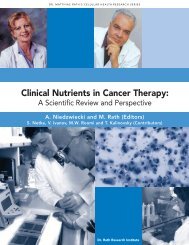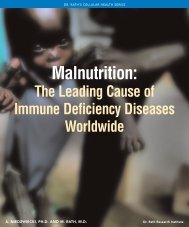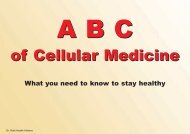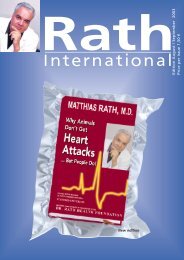Lectures - Dr. Rath Health Alliance
Lectures - Dr. Rath Health Alliance
Lectures - Dr. Rath Health Alliance
Create successful ePaper yourself
Turn your PDF publications into a flip-book with our unique Google optimized e-Paper software.
Background<br />
Everyone can take preventive measures against Alzheimer’s – you too!<br />
means of which memory can be<br />
improved and behavioural disorders<br />
temporarily alleviated. Of<br />
particular importance for patients<br />
suffering from dementia, however,<br />
is human care and attention,<br />
appropriate ways of<br />
handling odd and conspicuous<br />
conduct, activity and occupation<br />
for the patient and an environment<br />
that is geared to dementia.<br />
Alzheimer’s disease and cell<br />
vitality substances<br />
The course of Alzheimer’s disease,<br />
and its prevention, can be<br />
positively affected by the targeted<br />
use of cell vitality substances.<br />
Brain performance<br />
B vitamins are especially important<br />
for brain cells’ energy production<br />
and use, and necessary<br />
for maintaining the myelin<br />
sheath of nerve cells. Coenzyme<br />
Q10 and carnitine improve<br />
energy supply in the brain’s<br />
18 <strong>Rath</strong> International . October . 2003<br />
nerve cells. Coenzyme Q10 also<br />
simultaneously works as an<br />
antioxidant to protect against<br />
free radicals.<br />
Enhancing information<br />
links<br />
In Alzheimer patients, acetylcholine<br />
levels are often very<br />
low. This most important messenger<br />
substance in the brain is<br />
necessary for passing on information<br />
to other cells. Choline,<br />
inositol and pantothenic acid<br />
(vitamin B5) are important constituents<br />
of acetylcholine.<br />
Choline also enhances the effect<br />
of vitamin E as antioxoidant.<br />
Intercepting free radicals<br />
Intake of antioxidants is an<br />
especially effective and natural<br />
way of intercepting free radicals.<br />
For this purpose vitamins C<br />
and E should be given. Vitamin<br />
C is an energy supplier for nerve<br />
cell metabolism and protects<br />
against oxidation damage. Sele-<br />
nium too, and pycnogenol, take<br />
on defensive functions against<br />
free radicals.<br />
Lowering homocysteine<br />
levels<br />
Since Alzheimer patients show<br />
increased homocysteine levels,<br />
it is advisable to lower these<br />
with the help of cell vitality substances,<br />
since homocysteine can<br />
be toxic to nerve cells.<br />
Homocysteine is an intermediary<br />
breakdown product of the<br />
essential amino acid methionine.<br />
There are two ways in<br />
which homocysteine can be further<br />
processed in the metabolism:<br />
firstly, with the help of<br />
vitamins B6 and B12, and folic<br />
acid, homocysteine can be<br />
changed back into the amino<br />
acid methionine; secondly<br />
homocysteine can be further<br />
metabolised with the help of<br />
vitamin B6.<br />
The use of cellular medicine in<br />
treating Alzheimer’s aims to give<br />
an optimum supply of cell vitality<br />
substances to both healthy<br />
and already deteriorating nerve<br />
cells. Only by this means can the<br />
nerve cells regenerate and fulfil<br />
their function. There are no<br />
findings as yet from clinical or<br />
pilot studies about the use of<br />
cell vitality substances in<br />
Alzheimer’s disease.<br />
Janine Gehrt,<br />
nutritional scientist,<br />
Matthias <strong>Rath</strong> B.V.









